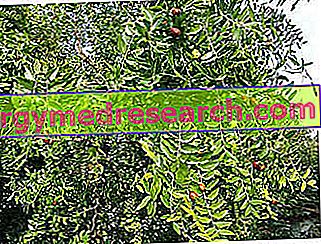See also: jujube broth
Ziziphus zizyphus
Ziziphus zizyphus is the Giuggiole plant, also known as Natsume, Tsao or more simply Chinese date .

There are conflicting opinions about the origin of the jujube: some authors believe that the plant is native to Asia - where it is still intensively cultivated - others are convinced that the jujube is native to northern Africa and that only later was it exported to the East. Nevertheless, all biologists agree that the jujube plant has been cultivated for over 4, 000 years.
Botanical description
The jujube plant has particular and unmistakable spiny and zigzag branches, with a reddish or brownish color. The bark is very wrinkled. The leaves, bright green, are leathery, alternate and ovate-bislong, with an imprecise, almost serrated edge; the flowers, pure white, sometimes greenish, are gathered in small inflorescences. The edible and fleshy fruits are the jujube (called "zizoea" and "zizoa" in the dialects of northern Italy), these fruits are as large as an olive, have yellowish pulp, brownish-brownish skin and sweet taste.

The seeds have a strong and hard endocarp: for this reason, they struggle to germinate. In order to obviate the inconvenience, it is advisable to cut the tips of the seed with appropriate scissors, to favor the penetration of the soil moisture and the consequent seed sprouting.
Jujube seeds should not be eaten because, in addition to the particularly pungent structure, they contain toxic glycosides.
Active principles
Jujube fruits are also used for phytotherapy purposes: after harvesting in September-October, jujubes are dried. In addition to a modest amount of sugars, pectin and mucilage, the jujube fruits also contain:
- anthraquinones
- Tannins
- Zizifusine: bisbenzyliso-quinoline alkaloid
- Daehuciclopeptide -I: cyclopeptide substances
- Ascorbic acid
- Flavonoids ( suvertisine )
- Tetracyclic triterpenic genine saponosides
[from A. Bruni's Dictionary of Herbal Medicine and Phytotherapy ]
Phytotherapic uses
In oriental medicine, the therapeutic properties of jujube are used to lighten the symptoms related to depression, physical fatigue, fatigue, irritability and nervousness. It seems that these supposed potentials of jujube, attributed to fruits from eastern cultures, find a certain scientific confirmation, in particular for sedative and hypnotic activities (rendered by saponosides).
The seeds (not the fruits) of the species Zizyphus spinosa have proved to be particularly appropriate to combat states of insomnia and nervousness.
In Chinese medicine, jujube is used as a tonic to reduce anxiety accompanied by palpitations and neurasthenia.
Due to the presence of anthraquinones, jujubes have a mild laxative effect.
The use of jujube fruits to relieve inflammation of the throat, bronchitis, colds and hoarseness cannot be forgotten.
It seems that the immoderate consumption of jujube fruits can inhibit sexual desire: in any case, there are no reliable demonstrations that support the theory.
Food Uses
The jujube fruits are edible and sweet; these can also be used to make jams, syrups and liqueurs, including the well-known jujube broth.
Summary
Jujube: in short
Jujube plant |
|
Giuggiolo: botanical description |
|
Jujube: main constituents |
|
Giuggiolo: medical-phytotherapeutic uses |
|
Giuggiolo: food uses | Fresh fruit consumption Jams Syrups liqueurs (jujube broth) |



